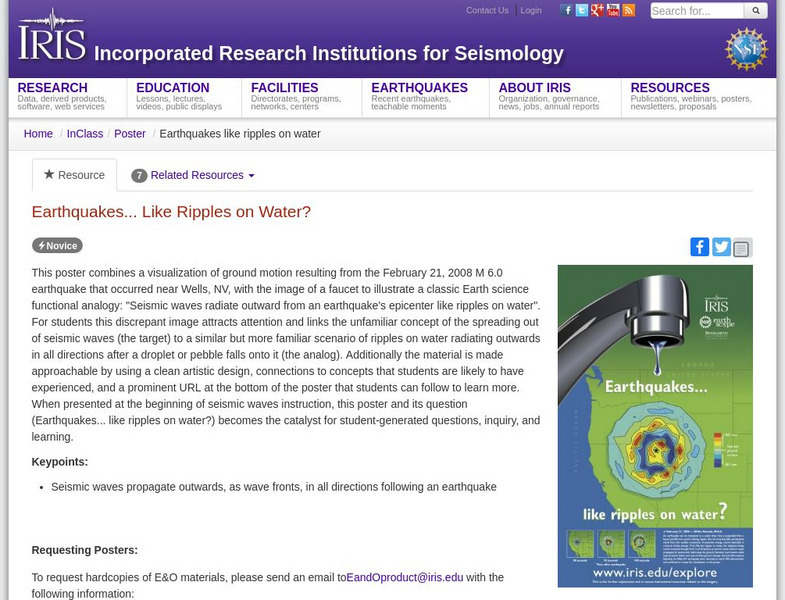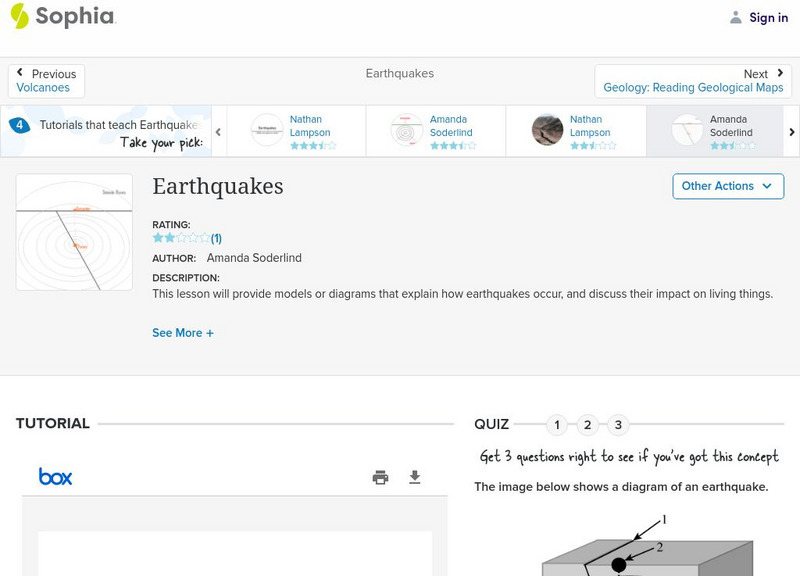Curated OER
Seismic Waves
Students work together to discuss seismic waves. Using seismograph records, they practice determining where the epicenter of the earthquake was located. They identify and illustrate the three types of waves and how the records can be...
Curated OER
Seismic waves
Students discover the differences between P- and S-waves using a slinky. They see that when displacement occurs along a fault, the built up strain of energy is released in the form of seismic waves.
Curated OER
What are Earthquakes?
Here is a scientific presentation of earthquakes. The elastic rebound theory is explained, as well as the different types of waves and how they are measured. Just a note: Slide number 15 has a diagram that is upside down. Enable editing...
Curated OER
Earth Science: In Depth Look at Earthquakes
Students engage in an interactive Internet lesson covering the reasons and results of earthquakes. After reading eyewitness accounts and viewing animations, they use seismograms to measure and locate the epicenters. In an ongoing study,...
Curated OER
GED Vocabulary: Earth and Space Science
In this earth and space science worksheet, students complete a crossword puzzle given 7 clues and a word bank about the solar system, earthquakes, currents and the Earth's crust.
Curated OER
GED Vocabulary: Earth and Space Science-Earthquakes
In this earth and space science worksheet, students complete a crossword puzzle given 7 clues and a word bank on topics such as earthquakes, erosion, galaxies and weathering.
Curated OER
Locate-a-quake
Student, use seismic readings of the same earthquake from three recording stations and locate the epicenter of an earthquake on a map.
Curated OER
Motions
Ninth graders differentiate between energy waves transmitted from a quarry or mine as opposed to energy waves transmitted by an earthquake. They analyze seismograms of blast events from at least two quarries or mines. The energy waves...
Curated OER
Seeing Sound and Sonar
Young scholars grasp how underwater animals can "see" using sound waves. They practice making inferences, and build a conceptual understanding of sonar radar.
K12 Reader
Earthquakes: Movement of the Earth's Crust
Readers use context to determine the meaning of words found in a short article about earthquakes and the movement of the earth's crust.
Curated OER
Survival Still
Lead your class to construct a solar still on campus to demonstrate how water can be extracted from the soil. The power of solar energy is emphasized, as is the concept of how capillary water can be recovered and purified by using a...
Curated OER
Incorporating 3D Visualizations into Your Classroom
Young scholars make observations through 3-D visualizations. They explore scientific and geologic processes through the use of 3-D pictures.
California Academy of Science
What Kind of Geologist Am I?
Transform your class into young geologists as they learn about six different branches of geology. Using the included geology career descriptions and picture cards, learners work in small groups deciding which tools and locations fit...
Curated OER
Earthquake Power
In this earthquakes worksheet, students learn about the measurements of earthquakes on the Richter scale. They answer six questions about the magnitudes and sizes of earthquakes using two tables of data about earthquakes and the Richter...
Curated OER
Seismology in the Classroom
Students work together to use a sample seismograph. They role play the position of an engineering firm that is to analyze the machine. They discover how engineers develop new machines to take measurements.
Curated OER
Conducting Research
Sixth graders write research reports about trains. They focus on mechanical features of trains.
Georgia Department of Education
Ga Virtual Learning: Earthquakes and the Earth's Interior
In this interactive tutorial you will learn about earthquakes and seismic waves. Learn about why and how these form and also discuss the hazards - direct and indirect - posed by earthquakes. You will then learn how our knowledge of...
Incorporated Research Institutions for Seismology
Iris: Exploring the Earth Using Seismology
The paths of some seismic waves and the ground motion that resulted are shown in this poster.
Incorporated Research Institutions for Seismology
Iris: Earthquakes, Like Ripples on Water?
See how seismic waves propagate outwards, as wave fronts, in all directions following an earthquake.
Sophia Learning
Sophia: Earthquakes
A quick, introductory lesson about how earthquakes happen, and what impact these natural events have on life.





















